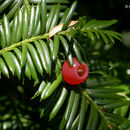More info for the terms:
shrubs,
tree,
vinePacific yew grows in a variety of cool and moist shaded habitats in
coastal lowlands and mountains [
5,
30,
32]. It occurs in canyon bottoms,
on moist forested flats near streams, and scattered at various upland
sites [
14,
30,
32]. At middle elevations in northern Idaho, it forms a
dense tangle of shrubs approximately 10 to 15 feet (3-5 m) in height.
Elsewhere, small groups or scattered individuals are more common [
5,
11].
Pacific yew grows on dry, rocky sites and in avalanche chutes west of
the Cascades [
5]. However, it is commonly found in warm, humid
concavities [
82]. Pacific yew is the most shade tolerant tree in the
Pacific Northwest [
62]. In less humid climates, it may actually require
shade [
41].
Plant communities: Pacific yew commonly grows beneath the dense shade
of western hemlock, Douglas-fir, and Pacific silver fir (Abies amabilis)
forests [
5,
68]. Although most often associated with relatively moist
plant associations dominated by western hemlock, Sitka spruce (Picea
sitchensis), and Pacific silver fir, it also occurs in relatively moist
microsites beneath species more typically associated with drier sites
such as ponderosa pine (Pinus ponderosa), incense cedar (Calocedrus
decurrens), Oregon white oak (Quercus garryana), Jeffrey pine (Pinus
jeffreyi), and knobcone pine (P. attenuata) [
11,
55,
68]. In parts of
eastern Oregon and California, Pacific yew is a prominent component of
white fir forests [
11,
54]. In northern California and southwestern
Oregon, it is common in mixed evergreen forests dominated by white fir,
Douglas-fir, canyon live oak (Quercus chrysolepis), chinkapin
(Chrysolepis chrysophylla), and Pacific madrone (Arbutus menziesii)
[
6,
7,
55,
82]. At the extreme southern edge of its range, Pacific yew
grows beneath sequoia (Sequoia sempervirens) [
11,
27]. In the northern
Rockies, it is associated with grand fir and western redcedar forests
[
11,
56]. Pacific yew also occasionally grows in warmer subalpine fir
(Abies lasiocarpa)-Engelmann spruce communities [
11].
Plant associates: Common plant associates in coniferous forests of the
northern Rocky Mountains include pachistima (Pachistima myrsinites),
northern twinflower (Linnaea borealis), menziesia (Menziesia
ferruginea), Rocky Mountain maple (Acer glabrum), blue huckleberry
(Vaccinium membranaceum), wild ginger, queencup beadlily, one-sided
wintergreen (Pyrola secunda), western rattlesnake plantain (Goodyera
oblongifolia), oneleaf foamflower (Tiarella unifoliata), and bunchberry
(Cornus canadensis) [
6,
13,
25,
81]. In southwestern Oregon and
California, vine maple (Acer circinatum), dwarf Oregon grape (Mahonia
nervosa), northern twinflower, salal (Gaultheria shallon), and hazel
(Corylus cornuta) grow with Pacific yew [
6,
67,
82]. Elsewhere in the
Northwest, Pacific rhododendron (Rhododendron macrophyllum), vine maple,
salal, western swordfern (Polystichum munitum), Oregon oxalis (Oxalis
oregana), Pacific dogwood (Cornus nuttallii), and oceanspray (Holodiscus
discolor) are common associates [
11].
Climate: Pacific yew grows in cool temperate and mesothermal climates
[
40,
41]. Abundance increases with increasing precipitation and
decreases with greater elevation and latitude [
40]. Average annual
precipitation ranges from 18 to 116 inches (47-294 cm) [
11]. Sites are
generally characterized by mild wet winters and warm dry summers [
14].
Pacific yew is moderately tolerant of frost, but the protection offered
by a layer of snow is necessary in continental climates [
41]. This
plant is resistant to flooding and survives temporary inundation [
41].
Soils: Western yew commonly grows on deep, moist, well-drained soils
[
62,
77] and is well adapted to acidic conditions [
41]. In British
Columbia, it tends to be most productive in alluvial habitats where
soils are nutrient-rich [
41]. A study conducted in the Bitterroot
Mountains of Montana and Idaho indicated that sites dominated by Pacific
yew have high levels of nitrogen [
51]. Pacific yew grows on soils
derived from a variety of parent materials including granite, diorite,
gabbro, serpentine, pre-Cambrian metasediments, schists, and gneiss
[
14,
42,
67,
79].
Elevation: Pacific yew grows at elevations ranging from 2,000 to 8,000
feet (610-2,438 m) [
62]. In Oregon, it occurs at low to middle
elevations [
74], and in British Columbia, it occurs from submontane to
subalpine habitats [
41]. Elevational ranges by geographic location have
been reported as follows:
Reference
from 3,200 to 7,000 feet (975-2,134 m) in MT [
17]
350 to 4,350 feet (104-1,329 m) in CA [
11]
< 7,000 feet (2,134 m) in CA [
55]
200 to 4,450 feet (60-1,350 m) in OR & WA [
11]

